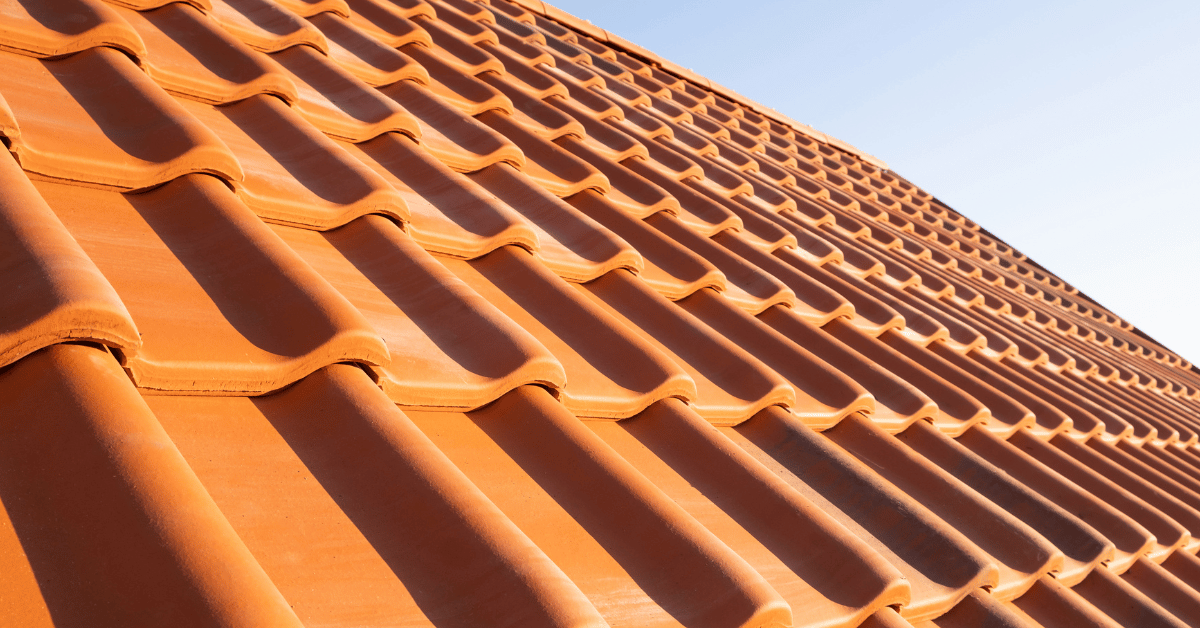As an experienced roof cleaning contractor, I’ve seen roofs of all kinds. From traditional shingles to modern metal, I’ve learned how to clean a roof through 20 years of hands-on work.
With careful planning, specialized equipment, and extensive knowledge, I’ve honed my skills to provide the best cleaning strategies for each unique roof.
In this article, I’ll share my expertise on cleaning strategies for every roof type, helping you keep your roof in top-notch condition for years to come.
Let’s dive into the art of roof maintenance together.
Key Takeaways
- Regular cleaning and maintenance are crucial for extending the lifespan and maintaining the integrity of all roof types.
- Different roof types require specific cleaning methods and solutions to address their unique characteristics.
- Gentle cleaning methods should be used to avoid damage to the roof’s surface, especially for wood shingles and shakes.
- If unsure about the cleaning methods for a specific roof type, it is recommended to consult professionals or hire a roof cleaning service to ensure proper care and maintenance.
Asphalt Shingle Roofs
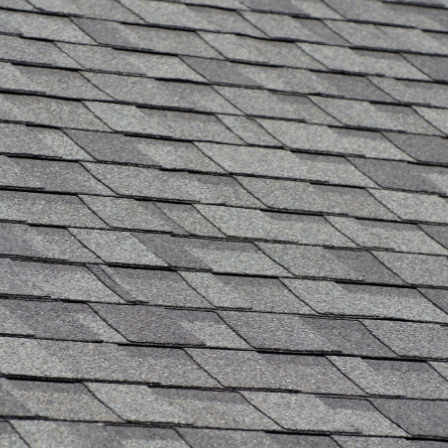
Asphalt shingles are one of the most common roofing materials. These shingles are known for their durability and affordability, making them a popular choice for homeowners.
When cleaning asphalt shingles, it’s essential to use gentle methods that won’t cause damage or premature wear.
Description
Over my 20 years of experience as a roof cleaning contractor, I’ve worked extensively with various types of roofs, including asphalt shingles. When it comes to cleaning asphalt shingle roofs, there are a few key characteristics to keep in mind:
- Texture: Asphalt shingles have a rough, coarse texture, providing traction and durability.
- Color: These shingles come in various colors, from traditional black and gray to vibrant shades like red and green.
- Vulnerability: Over time, asphalt shingles can become susceptible to algae and moss growth, which can compromise the roof’s integrity if not addressed.
- Maintenance: Regular cleaning and maintenance of asphalt shingle roofs are crucial to prevent the growth of algae and moss and extend the roof’s lifespan.
Best Way to Clean an Asphalt Shingle Roof
To effectively clean asphalt shingle roofs, I use a combination of gentle pressure washing and specialized cleaning solutions.
Cleaning your roof is important to maintain its appearance and extend its lifespan. Asphalt shingle roofs are susceptible to the growth of algae, which can cause discoloration and deterioration if left untreated.
To combat this, I first apply a cleaning solution specifically designed for asphalt shingle roofs. This solution contains bleach, which effectively kills the algae and removes stains.
I then use a pressure washer with low pressure settings to gently remove the algae and any other debris that may have accumulated on the roof. It’s crucial to use caution when pressure washing asphalt shingle roofs to avoid damaging the shingles.
Clean Your Metal Roof
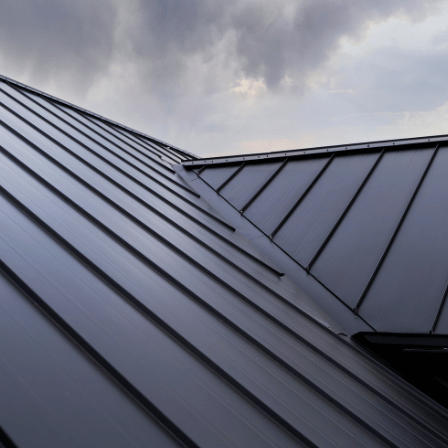
Understanding the unique characteristics of this roofing material is crucial for effective maintenance.
Metal roofs are known for their durability and resistance to various weather conditions, but they can still accumulate dirt, debris, and even algae over time.
It’s important to use non-abrasive cleaning solutions and gentle techniques to clean metal roofs to avoid damaging the surface while ensuring a thorough cleaning.
Description
As an experienced roof cleaning contractor, I’ve worked on various types of roofs, including metal roofing. Metal roofs are popular for many homeowners due to their durability and longevity. When it comes to cleaning a metal roof, there are a few key things to keep in mind:
- A clean roof is essential to maintain the integrity of the metal and prevent any potential damage.
- Using a pressure washer with a low-pressure setting effectively removes dirt, debris, and moss from the metal roof’s surface.
- A bleach solution can be used to eliminate algae and moss growth, which can be expected on metal roofs.
- It’s essential to be cautious when using any cleaning solution on a metal roof to prevent any potential damage to the surface.
Now that we understand the description of a metal roof let’s move on to the different cleaning methods that can be used to keep it in excellent condition.
Best Ways to Keep a Metal Roof Clean
Let’s dive into the various cleaning methods I’ve found effective in my 20 years of experience as a roof cleaning contractor.
When cleaning a metal roof, it’s crucial to use the proper techniques to avoid damaging the surface. First, remove loose debris from the roof, such as leaves or branches. Then, gently scrub the roof using a soft-bristle brush or a low-pressure washer to remove dirt and grime. Avoid using high-pressure washers, as they can dent or scratch the metal.
Additionally, be cautious around gutters, as excessive water pressure can cause them to detach. If you’re unsure about cleaning your metal roof, hiring a professional roof cleaning service is best to ensure the job is done safely and effectively.
Now, let’s discuss the cleaning methods for wood shingles and shakes.
Wood Shingles and Shakes
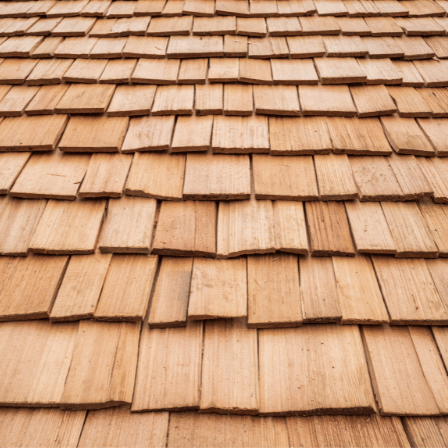
Having cleaned countless wood shingles and shakes, I can confidently say that understanding their unique characteristics is crucial for effective maintenance.
Wood shingles and shakes are made from natural materials, such as cedar or redwood, requiring specific cleaning methods to protect their integrity.
When cleaning these types of roofs, it’s essential to use gentle techniques and avoid harsh chemicals that could damage the wood.
Roof Description
Wood shingles and shakes are an excellent choice for homeowners looking to add a touch of natural beauty to their roofs. These roofs require regular maintenance to prevent issues such as roof leaks and ensure their longevity. Here is a description of wood shingles and shakes:
- Wood shingles are machine-cut and have a smooth, uniform appearance. They create a clean and polished look for a roof.
- Wood shakes are hand-split and have a more rustic and textured appearance. They add character and charm to the roof.
- Both wood shingles and shakes are made from different types of wood, such as cedar or redwood, which offer natural resistance to insects and decay.
- These roofs require regular cleaning to remove debris, prevent moss and algae growth, and maintain structural integrity.
When it comes to roof maintenance and cleaning strategies, it’s essential to use gentle cleaning methods and avoid harsh chemicals that can damage the wood. Regular inspections and timely repairs are also crucial to keep the roof in optimal condition.
Removing Algae and Moss
I’ve found that when cleaning wood shingles and shakes, it’s essential to use gentle methods and avoid harsh chemicals that can damage the wood.
Wood shingles and shakes are susceptible to algae growth, which can cause discoloration and deterioration over time. To clean them effectively, I recommend starting with a thorough rinse to remove loose debris.
Next, a low-pressure washing can be used to remove any stubborn dirt or stains. Using a cleaning solution specifically designed for wood roofs is crucial, as using a bleach solution can cause damage.
After cleaning, a final rinse should be performed to remove any remaining cleaning solution. With these gentle cleaning methods, wood shingles and shakes can be properly maintained and preserved.
Now, let’s discuss cleaning methods for clay and concrete tiles.
Clay and Concrete Tiles Cleaning Process
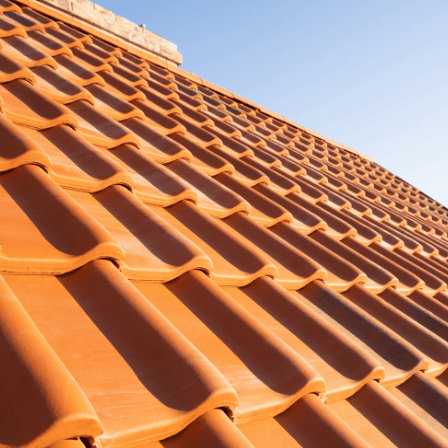
Having cleaned countless clay and concrete tile roofs over the past two decades, I can confidently say these materials require special care and attention.
Clay tiles are porous and can absorb stains, while concrete tiles can be more prone to algae growth.
A gentle approach is needed to clean both types effectively, using low-pressure washing and appropriate cleaning solutions.
Description
These tiles are known for their durability and aesthetic appeal, making them popular among homeowners.
Here is a description of clay and concrete tiles:
- Clay tiles: These tiles are made from natural clay and are known for their distinctive reddish-orange color. They have a smooth surface and a curved shape, giving them a classic and elegant look.
- Concrete tiles: Made from a mixture of cement, sand, and water, concrete tiles come in a variety of colors and textures. They can mimic the appearance of other materials, such as wood or slate, providing versatility in design.
- Long-lasting: Both clay and concrete tiles have a long lifespan, with proper maintenance and care.
- Resistant to algae: These tiles are less prone to algae growth than other roofing materials, reducing the need for frequent cleaning.
As a professional roof cleaner, I’ve extensive experience handling clay and concrete tile roofs. With the correct cleaning method, I can ensure that your roof remains clean and free from algae, enhancing its longevity and appearance. Trust our roof cleaning company to clean asphalt shingles and tackle any algae on your roof with expertise and precision.
Cleaning Methods
I typically use a gentle pressure washing technique when cleaning clay and concrete tiles. This method allows me to remove dirt, debris, and algae spores without causing any damage to the tiles. I use a pressure washer with a low psi to ensure the tiles aren’t forcefully blasted with water.
After the initial pressure washing, I assess the roof’s condition and determine if additional cleaning is required. Sometimes, I may need to use chlorine bleach and water to remove stubborn stains or algae growth effectively. However, it’s important to use caution when using bleach, as it can be harmful to plants and the environment.
Regular cleaning and maintenance are essential for preserving the longevity and appearance of clay and concrete tile roofs.
How to Clean a Slate Roof
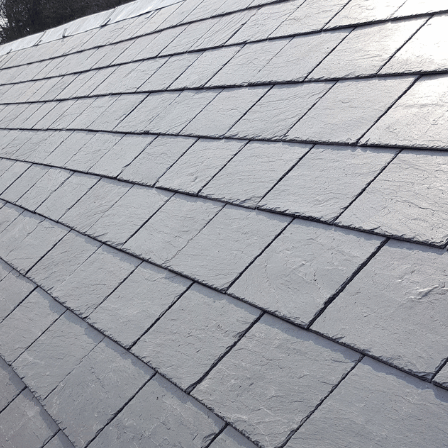
When it comes to slate roofs, there are a few key points to consider. First, slate is a durable and long-lasting material that requires minimal maintenance.
However, over time, it can develop a buildup of dirt, moss, and algae, which can affect its appearance and potentially cause damage.
To clean slate roofs, it’s important to use gentle methods that won’t damage the delicate surface, such as low-pressure washing and manual scrubbing with soft brushes and non-abrasive cleaning solutions.
Description
In my experience as a roof cleaning contractor, I’ve found that slate roofs require meticulous care and attention. Slate roofs are known for their durability and elegant appearance, but they can be challenging to maintain. Here’s a description of slate roofs and what makes them unique:
- Material: Slate roofs are made of natural stone, giving them a distinctive look and longevity.
- Texture: The surface of slate is smooth and flat, with a slightly rough texture that adds to its charm.
- Color: Slate comes in various colors, including shades of gray, green, purple, and blue, allowing homeowners to choose a roof that complements their home’s aesthetic.
- Weight: Slate roofs are heavy and require a sturdy support structure to withstand their weight.
Understanding the characteristics of slate roofs is crucial when developing cleaning strategies and conducting regular roof maintenance.
Now, let’s delve into the different cleaning methods for slate roofs.
Cleaning Methods
I’ve found that when it comes to maintaining slate roofs, it’s essential to employ specific cleaning methods tailored to their unique characteristics.
Slate is a delicate material that requires a gentle touch to avoid damage. One effective method is using a low-pressure washer to remove dirt and debris without causing any harm.
A bleach solution can also eliminate moss and algae growth that commonly occurs on slate roofs. However, diluting the bleach properly is crucial to prevent discoloration or damage to the slate.
Finally, a mild detergent can be applied and gently scrubbed with a soft brush for stubborn roof stains.
Composite or Synthetic Roofing
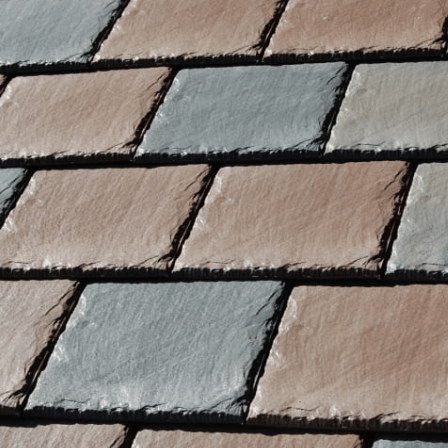
I’ve encountered many types of roofs over the past 20 years, including composite or synthetic roofing.
Composite or synthetic roofing is made from a combination of rubber, plastic, or asphalt and is designed to mimic the look of other roofing materials like slate or wood shakes.
When cleaning composite or synthetic roofing, it’s essential to use gentle cleaning methods to avoid damaging the surface and compromising its durability.
Description
I’ve successfully maintained and cleaned various types of roofs, including composite or synthetic roofing. Composite or synthetic roofing is becoming increasingly popular due to its durability and low maintenance requirements. Here is a description of this type of roof:
- Composition: Composite roofing comprises a mixture of materials, such as asphalt, fiberglass, and recycled materials. This combination results in a strong and weather-resistant roof.
- Appearance: Composite roofs come in a variety of colors and styles, mimicking the look of traditional roofing materials like wood or slate.
- Lifespan: Properly maintained composite roofs can last up to 50 years, making them a long-lasting option.
- Cleaning: To clean a composite roof, a gentle pressure wash is usually sufficient. Avoid using harsh chemicals or abrasive tools that can damage the surface.
Now that we’ve described composite or synthetic roofing, let’s discuss the best cleaning methods for this type of roof.
Cleaning Methods
I’ve found that the most effective method for cleaning composite or synthetic roofing is by using a gentle pressure wash.
Composite or synthetic roofs are durable and low-maintenance but require regular cleaning to remove dirt, debris, and mildew.
To start the cleaning process, I recommend using a pressure washer with a low-pressure setting to avoid damaging the roof. Alternatively, a garden hose with a spray nozzle can also remove loose debris.
For stubborn stains or mold, a mixture of bleach and water can be applied to the roof and gently scrubbed with a soft-bristle brush.
Afterward, the roof should be rinsed thoroughly with clean water to remove residue. If desired, a leaf blower can remove excess water and speed up drying.
Always follow safety precautions and manufacturer guidelines when using a pressure washer or cleaning solution.
Solar Tiles Cleaning
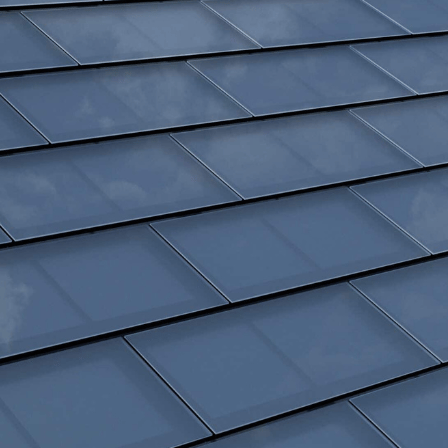
When it comes to solar tiles, it’s important to understand their unique characteristics and cleaning requirements.
Solar tiles are designed to harness the sun’s energy and provide electricity to a building, making cleaning methods crucial to maintaining efficiency and functionality.
Description
When maintaining these unique roof types, I follow specific cleaning strategies to ensure their longevity and optimal performance.
Here’s a description of solar tiles and the techniques I employ:
- Solar tiles are designed to harness the sun’s energy and convert it into electricity, making them an eco-friendly choice for homeowners.
- These tiles are typically made of durable materials such as tempered glass or polycrystalline silicon, which can withstand harsh weather conditions.
I avoid using a pressure washer to clean solar tiles as it can damage delicate solar cells. Instead, I use gentle cleaning solutions and soft brushes to remove dirt and debris.
Regular maintenance is crucial to prevent the growth of algae spores, which can hinder the tiles’ efficiency. I recommend scheduling professional cleanings at least once a year to keep your solar tiles in top shape.
Cleaning Methods
To maintain the cleanliness and efficiency of solar tiles, I continue employing specific cleaning methods that ensure their longevity and optimal performance.
When cleaning solar tiles, using a pressure washer isn’t recommended. The high-pressure water can damage the delicate solar cells, reducing efficiency or even complete failure. Instead, the best way to clean solar tiles is to use a low-pressure spray of water mixed with a mild detergent solution.
This solution effectively removes dirt, dust, and debris without causing any harm to the tiles. Additionally, it helps prevent moss growth and other organic matter from accumulating on the surface.
This gentle cleaning method lets you keep your solar tiles clean and functioning at their best for years to come.
How to Clean a Roof: Conclusion
After years of experience cleaning various types of roofs, I can confidently say that proper roof maintenance is essential for the longevity and performance of any structure. Neglecting roof maintenance can lead to many problems, including leaks, mold growth, and structural damage.
Here are some key takeaways to ensure your roof stays clean and in top condition:
- Clean asphalt shingles regularly to remove dirt, debris, and moss. This will prevent the growth of algae and moss, which can damage the shingles and cause them to deteriorate.
- Remember that algae doesn’t only affect asphalt shingles. It can also grow on other types of roofs, such as metal or tile. Regular cleaning and maintenance will help prevent algae growth and maintain the appearance of your roof.
- Inspect your roof at least twice yearly to identify any damage or wear signs. Look for cracked or missing shingles, loose flashing, and signs of water damage. Promptly addressing these issues will prevent further damage and costly repairs.
- Don’t underestimate the importance of maintaining a clean roof. Regularly removing debris, leaves, and other materials will prevent clogged gutters and drainage issues, which can lead to water damage and roof leaks.
In conclusion, proper roof maintenance is essential for the longevity and appearance of any roof type. By utilizing the appropriate cleaning strategies, such as gentle pressure washing or chemical treatments, you can ensure that your roof remains structurally sound and visually appealing for years to come.
Did you know that regular roof cleaning can extend the lifespan of your roof by up to 20 years? It’s a small investment that can make a big difference in the overall health of your home.

